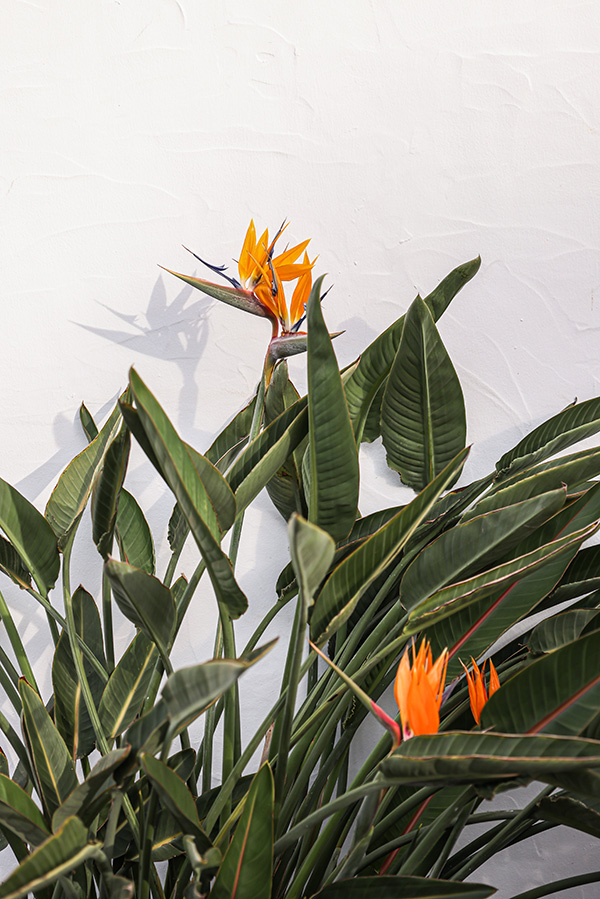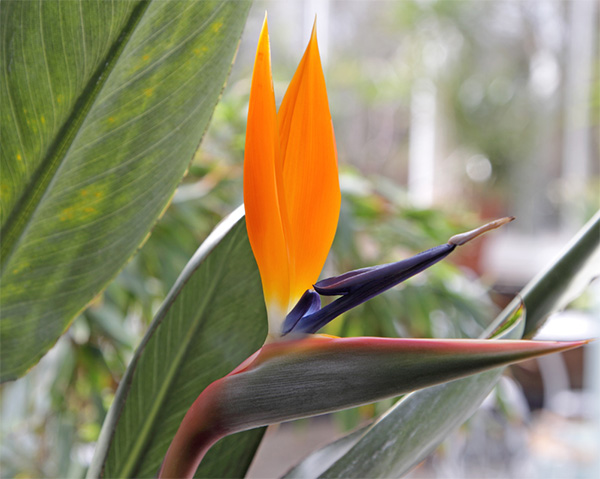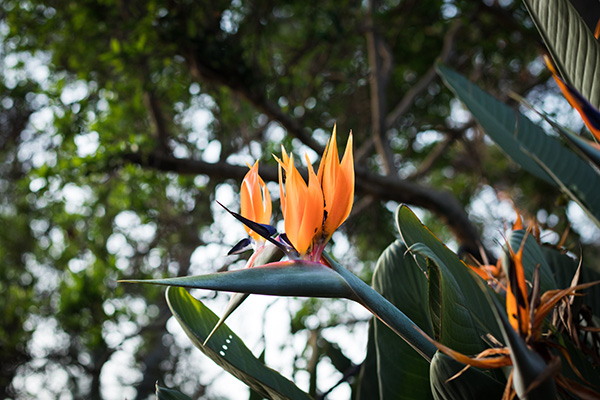Bird of Paradise is a tropical plant celebrated for its remarkable resemblance to the bird from which it takes its name. Native to South Africa, this exotic plant, with its vibrant blooms and lush foliage, has become a popular choice for adding a tropical flair to homes and gardens. Often used as ornamental landscape plants, these tropical plants are unique and striking plants with brilliantly colored flowers.
In this guide, we'll dive into the essentials of Bird of Paradise care, covering everything from optimal lighting conditions to watering, feeding, and pruning. Whether you're a seasoned gardener or a novice plant enthusiast, our tips and insights will help you create the perfect environment for your Bird of Paradise to thrive and bring its unique beauty to your space.
Botanical Name
Common Name
Plant Type
Mature Size
Sun Requirement
Soil Type
Hardiness Zone
Pet Friendly
Strelitzia reginae
Bird of Paradise
Perennial
5 to 30 feet tall, 3 to 10 feet wide
Full sun to partial shade
Rich, moist, well-draining
10-12 USDA
No
What is Bird Of Paradise
The Bird of Paradise, scientifically recognized as Strelitzia reginae, is a captivating plant that originates from South Africa. It is widely celebrated for its remarkable flowers, which are similar to a bird in mid-flight. This exotic perennial is part of the Strelitziaceae family and is known for its large, vibrant blooms, which display brilliant shades of orange, blue, and white. The plant features long, sturdy stalks and broad, green leaves that add to its lush, tropical appearance. Bird of Paradise plants can grow up to 4-6 feet tall, making them a dramatic and eye-catching addition to both indoor and outdoor spaces. They thrive in warm, sunny environments and are often used in landscaping and containers for indoor decor.
Bird Of Paradise Varieties
Strelitzia reginae (Common Bird of Paradise): The most well-known variety, it features vibrant orange and blue flowers that resemble a bird's head. This plant typically attains a height of 4-6 feet and is ideally suited for USDA hardiness zones 9-11. Thriving in environments with full sun to partial shade, it prefers well-draining soil.
Strelitzia nicolai (Giant White Bird of Paradise): Much larger than Strelitzia reginae, this giant bird of paradise variety can grow up to 20 feet tall. It produces white and blue flowers and has broad, banana-like leaves. Ideal for USDA zones 9-11, this plant thrives in either full sun or light shade. Due to its size, it's often used as an ornamental outdoor plant in tropical and subtropical regions.
Strelitzia juncea (Narrow-Leaf Bird of Paradise): This variety is similar to Strelitzia reginae in its flower color but has narrow, reed-like leaves. Reaching a height of up to 6 feet, this plant is well-suited for USDA zones 9-11. Strelitzia juncea prefers full sun, well-draining soil, and most drought-tolerant varieties. Its unique leaf structure makes it a striking addition to gardens.
Strelitzia caudata (Mountain Strelitzia): Known for its large, banana-like leaves and white flowers with blue bracts, this variety can reach up to 10 feet tall. Well-suited for USDA zones 10-11, this plant thrives in full sun to partial shade. It prefers well-draining soil and is frequently employed as a focal point in tropical gardens.

Bird Of Paradise Care Requirement
Light
The Bird of Paradise has specific light requirements for optimal growth, whether grown indoors or outdoors. For both indoor and outdoor settings, it's important to gradually acclimate the plant to changes in light conditions, especially when moving it from indoors to outdoors or vice versa, to prevent shock. Adequate lighting is essential for the Bird of Paradise to produce its signature vibrant blooms and maintain healthy foliage.
When cultivating a Bird of Paradise indoors, providing bright, indirect light is essential. A location near a south-facing or west-facing window where the plant receives plenty of light but is protected from the harsh midday sun is ideal. If natural light is insufficient, supplementing with grow lights can be beneficial. Inadequate light may result in diminished flowering and leggy growth.
Outdoors, the Bird of Paradise flourishes in locations with full sun to partial shade. In regions with intense sunlight, especially during the hottest part of the day, it's best to plant Bird of Paradise in a spot with some afternoon shade, which can be beneficial. This helps prevent leaf scorch while still ensuring the plant gets enough light for robust growth and flowering. In milder climates, full sun exposure is generally well-tolerated.
Water
The Bird of Paradise requires consistent and careful watering, whether grown indoors or outdoors, though the frequency and amount will vary based on the environment and the plant's growth stage. Newly planted Bird of Paradise and warm growing season will need more frequent watering. It is advisable to use lukewarm water for indoor or outdoor plants, as cold water can potentially shock the roots. Proper watering is key to keeping your Bird of Paradise healthy, encouraging lush foliage and vibrant blooms.
When cultivating the Bird of Paradise indoors, it should be watered thoroughly, allowing the top inch of soil to dry out between waterings. Over-watering can result in root rot, making it crucial to ensure that the pot has proper drainage. During the winter months, when the plant is not actively growing, reduce watering frequency. The indoor environment's humidity and temperature will also influence the soil's drying rate, so adjusting watering is important.
Outdoor Bird of Paradise plants typically require more frequent watering than indoor ones, especially in warmer and drier climates. Maintain the soil consistently moist, avoiding waterlogging. In hotter months, this may mean watering the plant several times a week, while in cooler or wetter conditions, less frequent watering is necessary. Adjusting watering based on rainfall, temperature, and soil moisture levels is important.
Temperature
The Bird of Paradise, originating from a warm South African climate, thrives in a temperature range that supports its tropical nature.
Ideal temperatures for the Bird of Paradise are between 65°F to 70°F (18°C to 21°C) and above. It can tolerate higher temperatures well, particularly when adequate moisture and humidity are provided. However, protecting the plant from extreme heat, especially outdoors, is important to prevent leaf scorch and dehydration.
During the cooler months, the Bird of Paradise can withstand slightly lower temperatures but should avoid cold drafts and frost. The Bird of Paradise is not frost-tolerant and can be susceptible to damage at temperatures below 50°F (10°C). If grown outdoors, it should be in a region where temperatures do not typically drop below this range, or it should be brought indoors or given protection during colder periods.
Ensuring a consistent temperature within this specified range is crucial for the plant's well-being and flowering. It's important to avoid abrupt temperature fluctuations, as they can induce stress in the plant and impact its overall growth. By providing the Bird of Paradise with a warm, stable environment, you can enjoy its lush foliage and striking blooms for many years.

Humidity
Thriving in tropical conditions, the Bird of Paradise prefers highly humid environments. It prefers humidity levels of around 60% or higher, which is more than what is typically found in average home settings.
In indoor settings, particularly in homes with dry air resulting from heating or air conditioning, it is essential to enhance the humidity around the Bird of Paradise plant. This can be done in several ways:
Misting: Regularly misting the leaves with water can help increase the local humidity. Nevertheless, it's worth noting that this approach often offers only transient relief.
Humidifier: An effective method to sustain consistent humidity levels is using a humidifier near the plant.
Tray with Water and Pebbles: Another helpful technique is to place the plant pot on a tray filled with water and pebbles. As the water in the tray evaporates, it enhances the humidity around the plant, and the pebbles ensure that the pot remains above the water, preventing potential issues like root rot.
Grouping Plants: Creating a microenvironment with elevated humidity can be achieved by grouping multiple plants together, as their collective transpiration contributes to increased moisture in the surrounding air.
Outdoors, the Bird of Paradise is usually less affected by low humidity, particularly if it's in a naturally humid environment. However, in arid or dry climates, providing additional moisture through regular watering and possibly misting can be beneficial.
Soil
The Bird of Paradise thrives in soil that balances drainage, aeration, and moisture retention. An ideal base for this plant is a well-draining, loamy soil enriched with organic matter. To enhance drainage and prevent waterlogging, it is recommended to incorporate perlite or coarse sand into the soil mix, as excessive moisture can lead to root rot. Adding peat or coconut coir is beneficial for retaining moisture and maintaining soil structure, preventing compaction.
The Bird of Paradise prefers a slightly acidic to neutral soil pH, typically ranging between 6.0 and 7.0. Regular pH monitoring and adjustments are important to maintain this range. When potting the plant, opt for a container with ample drainage holes to facilitate the easy escape of excess water.
The right soil composition is key to supporting the Bird of Paradise's healthy root development, which is crucial for its overall health and the ability to produce its characteristic vibrant blooms. Tailoring the soil mix to the specific conditions of your growing environment will aid in successfully cultivating this striking plant.
Fertilization
Fertilizing the Bird of Paradise is essential for its growth and flowering, but it should be done carefully to avoid overfeeding. An ideal fertilizer for the Bird of Paradise is a balanced, water-soluble formulation with equal parts nitrogen, phosphorus, and potassium. Options like a 10-10-10 or 20-20-20 blend or a fertilizer specifically designed for flowering plants can be suitable. These nutrients contribute to overall plant health, robust leaf growth, and vibrant flower production.
During the active growing season in spring and summer, fertilize the plant every two weeks to provide consistent nourishment. During the natural slowdown of growth in the fall and winter, it is advisable to decrease the frequency of fertilization to once a month or consider discontinuing it altogether. It's important to dilute the fertilizer to half the strength recommended on the package to prevent the risk of fertilizer burn, which can damage the roots and leaves.
Organic fertilizers like fish emulsion, seaweed extract, or compost are also great options, as they feed the plant and enhance soil health over time. Adhering to these fertilization guidelines will help ensure your Bird of Paradise maintains its lush foliage and produces its signature flowers while avoiding potential harm from overfeeding.
Propagation
Propagating a Bird of Paradise involves dividing the plant's root system, as it does not typically propagate well from seed or cuttings. The optimal time for propagation is during the spring or early summer when the Bird of Paradise is in an active growth phase. Here's how to propagate a Bird of Paradise:
Water the plant thoroughly a day before you plan to divide it. Choosing this time for propagation can alleviate plant stress and facilitate the separation of roots.
Carefully extract the Bird of Paradise from its pot or carefully dig it up if planted in the ground. Gently shake off any excess soil from the roots to clearly observe the root structure.
Examine the root clump for natural divisions, ensuring each division possesses at least one stem and a healthy set of roots. Utilize a sharp and clean knife or spade to separate the clumps into smaller divisions carefully. Be gentle to minimize damage to the roots.
Plant each separated division in its pot using well-draining soil. Ensure the pots have drainage holes. Water the newly potted divisions thoroughly.
Maintain the soil consistently moist, avoiding waterlogging, and position the pots in a location with bright, indirect light. For the initial weeks, avoid exposing the new plants to direct sunlight to prevent undue stress.
The new divisions may take several weeks or even a few months to establish roots and start new growth. Once established, you can care for them like a mature Bird of Paradise.

Common Problems And Troubleshoots
Yellowing Leaves
Yellowing leaves in Bird of Paradise plants can be a sign of overwatering, which leads to poor root health and nutrient uptake. To prevent issues, ensure the soil is well-draining and water only when the top inch of soil is dry. Conversely, insufficient watering can also lead to yellowing. Establishing a regular watering schedule helps maintain consistent soil moisture without the risk of overwatering.
Brown Leaf Tips
Brown tips on the leaves often indicate low humidity, a common issue for indoor plants. Enhance humidity levels by regularly misting the leaves, using a humidifier, or placing the plant on a tray filled with water and pebbles. Brown tips can also result from over-fertilization. If this is the case, reduce the frequency and strength of fertilizer applications.
Lack of Flowering
Mature plants can produce up to three dozen flower stalks annually. To achieve this, a Bird of Paradise needs ample sunlight to produce flower stalks. If your Bird of Paradise isn't blooming, insufficient light may be the cause. Relocate it to a brighter location where it can receive several hours of direct sunlight daily. Patience is crucial, especially with younger plants, as it may take several years for them to mature enough to produce flowers.
Pests
Bird of Paradise plants can be susceptible to infestations by spider mites, mealybugs, and scale insects, especially in dry air conditions. Regularly examine your plant for indications of pests and promptly address any infestations with insecticidal soap or neem oil. Maintaining cleanliness and increasing humidity are additional measures that can aid in preventing pest problems.
Root Rot
Root rot is a severe problem arising from excessive watering and poor drainage. If there are indications of root rot, take the plant out of its container, examine the roots, and cut off any black or mushy parts. Replant the specimen in new, well-draining soil, and modify your watering routine to prevent recurring problems.
Leaf Splitting
Some leaf splitting is normal and helps the plant withstand wind. However, excessive splitting may indicate too much wind or physical damage. Outdoors position the plant in a spot sheltered from strong winds to protect it from potential damage. Indoors, ensure it's not in a spot where it's frequently brushed against or disturbed.
Is Bird Of Paradise Pet Friendly?
The Bird of Paradise is not pet-friendly, as it can be toxic to dogs and cats if ingested. The Bird of Paradise is included on the list of toxic plants for pets by the American Society for the Prevention of Cruelty to Animals (ASPCA).
Ingesting parts of the Bird of Paradise plant can cause mild to moderate pet symptoms, including nausea, vomiting, and drowsiness. The fruit and seeds of the Bird of Paradise are particularly problematic, although all parts of the plant have the potential to cause discomfort if ingested.
If you have pets, keeping the Bird of Paradise out of their reach is advisable. If you suspect your pet has ingested any part of a Bird of Paradise plant, promptly contact your veterinarian for guidance. To safeguard the well-being of your pets, it's advisable to choose plants that are safe for them in both your home and garden.

